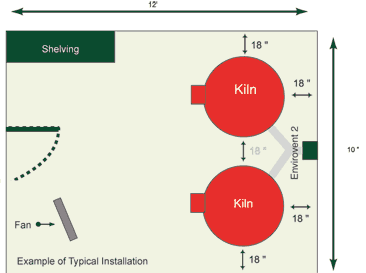General Installation
A great deal of effort and money can be saved by taking the time to properly plan the layout for your studio.
The most important things to consider when laying out your kiln room are:

- Proper Kiln Clearances
- Storage For Unfired and Fired Ware
- Electrical & HVAC Requirements
- Venting Requirements –
ENVIROVENT2 DUCT SIZE CHART - Future Needs
Kiln Clearances
Most building codes refer to the manufacturers recommendations when judging proper clearances from combustible walls. Skutt suggests that the kilns be at least 18″ from any wall. Part of the reason for the clearance is to minimize the heat which is reflected back to the kilns circuit board. Kilns without circuit boards may be placed as close as 9″ to a wall.
Storage
It will be convenient to have shelving in the kiln room to place ware that is to be fired and ware that is unloaded from the kiln. Be sure not to place shelves above the kilns and also allow for proper clearance.
Electrical & HVAC Requirements
Before you can order your kiln you must determine what sort of power you have available in your building.The most common voltages are 208 volt and 240 volt. Many people think they have 220 volt power because most appliances are designed to run off either voltage and are labeled 220. To have 220 voltage is very uncommon in the USA. Have an electrician check to be sure.
If you are in the process of finding a location it would be advisable to have an electrician test the strength of the power to the building. Power supplies with low voltage can cause problems with your firing and are very expensive to remedy.
Next determine what phase power is in your building. Most residential buildings have single phase power which consists of 2 hot wires and a ground wire. Many commercial areas have 3 phase power available which consists of 3 hot wires and a ground. Either phase power supply will work.
When choosing a spot to locate your kilns try and stay within a 50 ft wire run from your breaker box. If it is necessary to run the power farther then 50 ft you will need to increase the wire gauge to the breaker box.
Make sure that the total amount of amperage available is enough to run all of the equipment and fixtures you will be using. Increasing the amperage supply to your building can be very expensive.
The KM1227-3 kilns come with a plug attached to the power cord. It will be necessary to have an electrician install a receptacle to fit your particular plug configuration.
EnviroVents will require standard 120 volt outlets within 8 ft of each kiln. It is also a good idea to have additional 120 volt outlets available to run fans. The fans will help keep the room temperature down and help the kilns cool significantly faster.
If your studio is going to be located in a location such as a mall where heating , ventilation , and air conditioning or HVAC, are shared by the whole building structure the leasing office will want to know how your equipment will effect this system. Specifically they will want to know how much heat the kilns are generating, which is measured in BTU’s, and how much room air you are venting out with the EnviroVent, which is measured in CFM’s. All of this information can be found in the specifications section of this pamphlet.
Venting Requirements
The Skutt EnviroVent 2 is easy to install. A designated number of holes are drilled in the lid and floor of the kiln either in the factory or on location. A spring loaded plenum cup is placed under the kiln and tensioned between the kiln and the floor under the kiln. The holes in the floor of the kiln are drilled in a tight pattern so the plenum cup can cover them all. The other end of the cup is connected by 3″ ducting to a fan which is generally mounted on the wall. On the opposite end of the fan the air is ducted through the wall to the outside air.
For specific instructions on various Envirovent 2 installations please consult the EnviroVent 2 Operating Manual.
For recommended duct size for venting distance please refer to our EnviroVent 2 Duct Size Chart.
Future Needs
Remember to keep in mind future growth of the business when you are planning the layout of your kiln room. Are you allowing enough room to add another kiln? Is the electrical supply designed to allow for the additional amp draw of another kiln? Are there enough outlets available for additional vents and fans? You can save a lot of frustration down the road by addressing these issues now.

